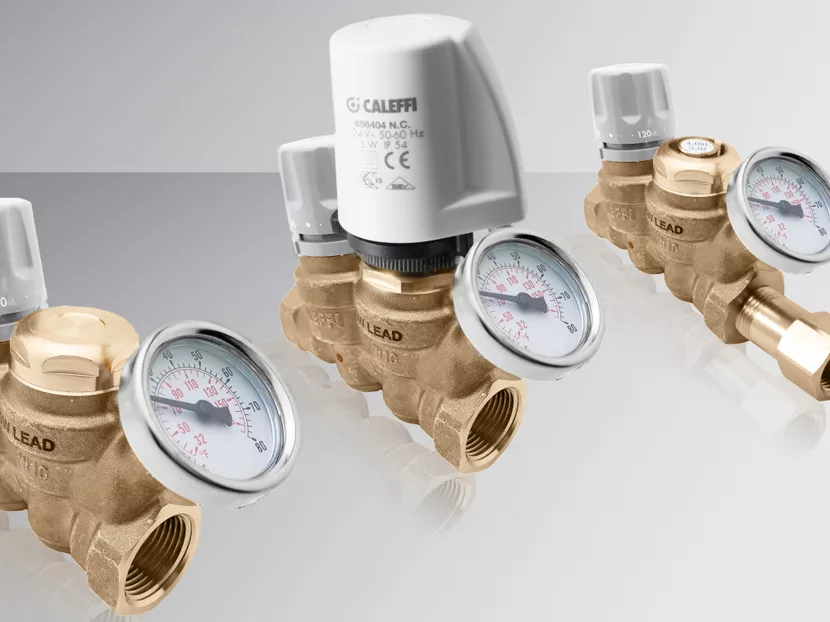Within a multi-circuit hot water recirculation system that uses traditional mechanical balancing valves, significant fluctuation of water temperature can occur due to the cyclical periods of hot water demand and fluctuation in the supply temperature from the hot water source.
A new type of valve called a thermal balancing valve, Caleffi’s ThermoSetter, can control water temperature in the circuits more precisely. This is because it modulates flow to maintain a set temperature while the above-described hyperdynamic conditions occur. The result is the avoidance of excessively low or high temperature at the fixtures and significant savings in pump electrical energy costs.
The ThermoSetter temperature set-point is field adjustable from 95 F to 140 F. An internal thermostatic cartridge expands and contracts in response to the water temperature entering the valve, thus modulating flow. It allows full flow through the valve at ambient temperature; as the water heats and the temperature approaches the user-set value, the valve closes until the set value is reached.
At this position, the valve is in a “not quite closed” position, which allows only a small watchdog amount of water to flow for ongoing sensing. And as the valve closes, more of the circulator’s head is available to distribute hot water quickly to the other branches, thus resulting in effective automatic thermal balancing. It also ensures a constant temperature in the recirculation piping system.
As water temperature entering the ThermoSetter then decreases, which occurs with little or no hot water demand at the fixtures over time or as temperature drop in the water heater occurs, the balancing cartridge contracts to allow more water to flow within the circuit. This continual expansion/contraction action within the valve ensures precise domestic hot water circulation in each circuit of the system.
The ThermoSetter is the only thermal balancing valve that is field adjustable. The adjustment knob also can be locked to prevent tampering; it has a dry well that houses an optional temperature gauge or it can be used to place a temperature probe for remote measurement of recirculation and control if disinfection is being performed.
For systems performing thermal disinfection to guard against Legionella growth, a model with a second bypass thermostatic cartridge automatically opens when water temperature increases to 160 F, thus allowing maximum circuit flushing. Alternately, circuit flushing can be enabled during thermal disinfection using models configured with a bypass cartridge that is activated via a thermal-electrically activated zone valve.
The most valuable feature is the ability for the valve temperature set-point to be field adjusted. It allows the contractor to fine-tune the temperature resulting at the fixtures, even when the installed piping does not exactly match the original design. Additionally, the thermostatic cartridge can be serviced without having to remove the valve from the pipe, such as when the valve needs de-liming, a common occurrence for any modulating valve within a DHW recirculation system.
Labor Savings with Design Confidence
Automatic self-balancing is starting to transform commercial domestic hot water balancing. Contractors are realizing the convenience of the ThermoSetter adjustable thermal balancing valve, which eliminates the need for time-consuming manual balancing labor and equipment. What normally consumes hours or even days and requires expensive instrumentation can be completed in a fraction of time with no instrumentation and without a highly trained balancing contractor.
In addition to labor savings, the automatic self-balancing provides the plumbing designer with higher confidence that his specified recirculation temperatures will be realized.
“If a portion of a manually balanced DHW recirculation system is modified during a tenant renovation, the system should be rebalanced entirely, despite the fact that only a portion of a domestic water system may have been modified,” says Chris Sbararo, PE, senior project engineer with Grumman/Butkus Associates in Evanston, Illinois. “This expensive process is eliminated if thermal balancing valves were initially installed instead.”
Electrical Savings
The ThermoSetter valve matches perfectly with smart, variable-speed recirculation pumps, resulting in electrical savings. Thermal balancing is the only technology available to avoid wasted pumping energy during periods of DHW demand while leveraging the energy-saving potential of today’s smart pumps.
During periods of DHW demand, the ThermoSetter valve throttles to minimum position, allowing the smart pump, operating under constant differential pressure or proportional differential pressure mode, to automatically reduce speed and electrical consumption.
“Using thermal balancing valves is one of the best ways to meet IECC 2015 requirements,” notes Ryan Boogaard, PE, principal-mechanical engineer with Spectrum Engineers in Salt Lake City.
Sbararo adds, “With the hot water recirculation requirements of IECC 2015, balancing of the domestic hot water system has become more challenging given that more balancing valves are being installed than in the past. Utilization of thermal balancing valves provides a way to ensure the DHW system is properly balanced upon initial construction and after any plumbing-related renovations.”
Thermal balancing valves are a temperature solution for a temperature problem. Placed in each hot water return branch, they self-balance, negating the need for instrumentation. Through periods of no demand, delivery temperature fluctuation and water heater drawdown, they modulate harmoniously to maintain consistent hot water temperature at the fixtures.
“[Thermal] balancing valves are a great option for design engineers to simplify hot water systems and comply with energy codes,” concludes Jason Robison, mechanical EIT with Parkhill Smith and Cooper, Lubbock, Texas.
Woody Dickinson is the Marketing Technical Manager at Caleffi North America, Inc. Visit www.caleffi.com.




